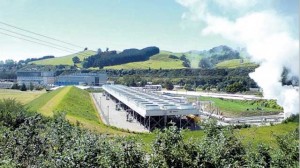 WASHINGTON, USA (CMC) –The World Bank says a multi-donor initiative, led by its Energy Sector Management Assistance Programme (ESMAP), has mobilised US$235 million through the Clean Technology Fund towards scaling up geothermal energy in developing countries, including the Caribbean, since it was launched a year and a half ago.
WASHINGTON, USA (CMC) –The World Bank says a multi-donor initiative, led by its Energy Sector Management Assistance Programme (ESMAP), has mobilised US$235 million through the Clean Technology Fund towards scaling up geothermal energy in developing countries, including the Caribbean, since it was launched a year and a half ago.
Noting that geothermal energy is an “important source of low-carbon base-load power for many developing countries”, the Washington-based financial institution said projects have been identified and are now under preparation in the Caribbean, Latin American, Africa, Eastern Europe and Central Asia, and East Asia and the Pacific.
The bank said that the Global Geothermal Development Plan brings together development partners to address one of the key barriers to the expansion of geothermal energy in developing countries: limited capacity and capital available for early-stage exploration — “a phase that is costly and during which a developer’s equity can be locked in for many years with uncertain returns.”
“For many developing countries, geothermal has the potential to contribute clean, reliable, locally-sourced power that can expand access to electricity, grow the economy, create jobs, and boost prosperity,” said Anita Marangoly George, the senior director of the World Bank’s Energy and Extractives Global Practice.
“But to succeed, development partners and governments will need to work together to mitigate exploratory risks and help pave the way for scale up by the private sector,” added George, speaking at the second roundtable of the Global Geothermal Development Plan in Copenhagen, Denmark.
The event, co-organiSed by ESMAP and the Climate Investment Funds, brought together government and donor representatives, technical experts and private developers from more than 30 countries to assess the state of progress in the sector and discuss key issues and lessons learnt in geothermal development, specifically in the areas of exploration data management, risk mitigation options, and financing alternatives for geothermal investments.
Karl Gawell, Executive director of the Geothermal Energy Association, told delegates that momentum was building for geothermal energy in low- and middle-income countries.
“It is in its early stages, but it is happening, and it will mean strong growth for geothermal energy in the days ahead,” Gawell said.
Since its launch by ESMAP in March 2013, the Global Geothermal Development Plan has not only mobilised donor funding but also contributed to developing a pipeline of resource validation projects, and helped focus global attention on the potential for geothermal energy to contribute to the transition to renewable energy in developing countries, the World Bank said.
It said these efforts culminated with the allocation of US$235 million for early-stage exploration by July 2014 through the new Dedicated Private Sector Programme window of the Clean Technology Fund.
The World Bank said these new resources will provide a “much-needed boost to the existing efforts undertaken by multiple donors as part of the Global Geothermal Development Plan in 11 countries”: Turkey, Armenia, Indonesia, Kenya, Ethiopia, Djibouti, Mexico, Chile, Nicaragua, Dominica and St. Lucia.
The bank said these efforts could also be expanded in the near future.
To date, it said ESMAP has identified 36 geothermal fields in 16 countries where surface exploration has been completed and additional financing is needed in the near future to confirm the commercial viability of geothermal resources.
The World Bank estimated that as many as 40 countries could meet a large proportion of their electricity demand through geothermal power.
New assessments show that in the longer term the number of countries where geothermal energy could significantly increase is much larger, the bank said.
With more public investment and improved knowledge about resource endowments paving the way for private investments, it said geothermal could play a much larger role in the Caribbean, Latin America, East Africa and Southeast Asia, as well as areas of Eastern Europe and Central Asia.
“Clearly, there is real alignment, at both the global and country levels, to take advantage of a clean energy source that for too long has been under-exploited,” George said. “This is especially important in a world where global energy prices remain volatile, and where energy security and sustainability matter more than ever.”
The World Bank said throughout its history it has provided US$2.2 billion in financing for geothermal energy projects.
